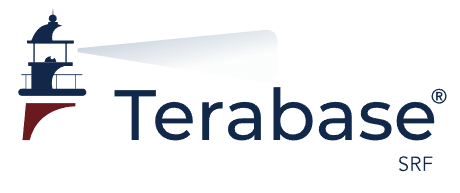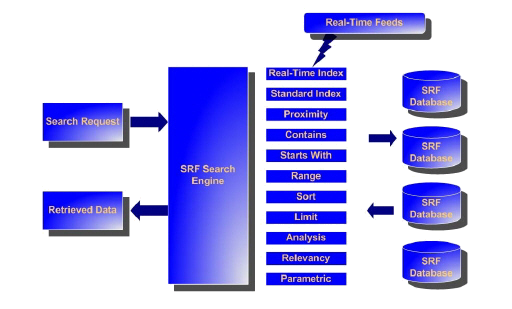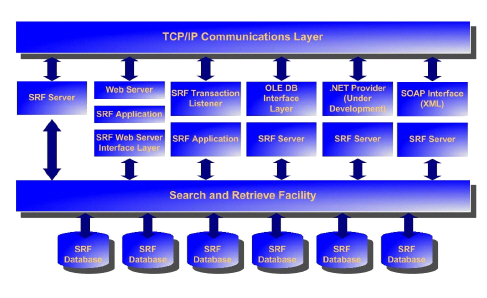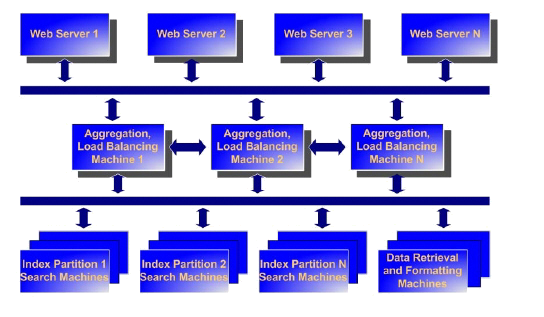
Terabase®/SRF Overview
Terabase®/SRF Search and Retrieval Facility enables the development of fast and efficient online databases for information providers. This third generation search engine technology has proven itself in continuous use since 1994, in a wide variety of applications.
Terabase®/SRF uses a high performance searching system optimized for fielded databases, yet has the necessary attributes to index and retrieve text at high performance. Terabase®/SRF performs at a high level, even with extremely large databases.

Developers may utilize a number of Application Programming Interfaces (APIs), including , COM-object, XML Web Servers, or lower level socket interfaces, depending on the level of control and performance desired. A .NET provider is currently under development, in order to provide easy access from Microsoft’s popular new .NET Framework. A special order OLE-DB provider is available under special licensing terms.
Terabase®/SRF has tools for customized loaders and indexers for performing batch-oriented updates. When necessary, real-time updates for immediate access data can be customized to your application.
Terabase®/SRF databases provide “Optimized Navigation”, so that retrievals and set-based operations minimize traffic between the client and the server. At the same time, our custom applications guide the user to the best set of information needed to answer key questions.
The Terabase®/SRF Search and Retrieval Facility has a wide range of indexing and searching options that make it easy to develop high performance search applications for information publishing.
Terabase®/SRF has a wide variety of indexing structures — represented in the diagram here. Through the use of Standard Indexes, Proximity, Range, and a number of other methods, the developer can tune the overall performance of the final application in a number of ways.

Developers may access a single database, or a number of databases, with simple query instructions. After each iteration of search, the selected set may be narrowed further for additional results.
For those applications that require a real-time interface, Terabase®/SRF has a customized Real-Time Feed capability that allows the developer to integrate real-time data updates with the standard search engine on a rolling basis.
The best way to see what Terabase®/SRF can do for your application is to request a trial application today. Our prototyping methodology allows the customer to see the benefits of the Terabase®/SRF system on your specialized application.
The Terabase®/SRF Search and Retrieval Facility supports a wide range of data types, so that you can build the kind of retrieval systems that you want — whether the systems are full-text or fielded information.
| Supported Index Types | ||
|---|---|---|
| String / Dates | Numerics | Multimedia |
| Character | Binary Integer | Blob |
| Date | Fixed Point Decimal | Image* |
| Time | Floating Point | Sound |
| Date/Time | Video | |
| * Image, Sound, and Video Multimedia types are available for storage only, and are not indexable in the search engine. | ||
All data fields are stored in blobs, and are formatted into specific data types through the use of dynamic formatting routines. This provides the highest level of flexibility in data compression, storage requirements, and performance tuning for information retrieval.
Native Index types are shown below. Additional data types may be constructed as composite fields, or calculated fields. Calculated fields can be created with a wide range of algorithms, so that you may create indexes on completely virtual data fields.
Indexes can be stored multiple ways for the same data field in order to provide the highest retrieval performance. For example, special format numbers can be stored with and without formatting.
Terabase®/SRF Search and Retrieval Facility provides a wide array of database access methods. Because it supports the standard interfaces that your programmers are familiar with, your development staff will be able to be immediately productive.

Whether through the use of OLE/DB, XML Web Interface, a standard Web Server programmable interface, or the future .NET Provider, Terabase®/SRF will provide you with an easy interface to the high performance database systems. If requested, we can provide full Web Services capability with SOAP/WSDL interfaces on a special order basis.
Terabase will work with you to provide the highest performance interface, depending on your particular needs.
And because it uses standard interfaces, you may use the languages you are familiar with to develop your applications. No longer are you limited to a short list of application environments — if you can imagine the way to access the data, we can build the support for it.
Bring us your information distribution problem today, and we’ll show you the kind of performance you can get with Terabase®/SRF!
Terabase®/SRF Search and Retrieval Facility is available in a Distributed Search Facility version. This multi-system version of the Terabase engine provides extremely high performance for huge databases.

Using multiple Web servers, Aggregation and Load Balancing machines, and separate machines for indexes, Terabase/SRF Distributed Search Facility will provide scaleable performance through the complete range of databases — regardless of records, or the number of items that need to be indexed.
Terabase®/SRF Distributed Search and Retrieval Facility is designed to use the same tools as the standard edition, while providing a level of performance and search capability that is orders of magnitude more scaleable than other environments.
Call Terabase today, and we’ll evaluate whether the Distributed Search Facility is the right environment for your application. If so, we’ll work with you to architect a solution that can fit your growth needs now and into the future.
Terabase — When performance counts!